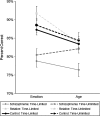Temporal lobe structures and facial emotion recognition in schizophrenia patients and nonpsychotic relatives
- PMID: 20484523
- PMCID: PMC3196942
- DOI: 10.1093/schbul/sbq046
Temporal lobe structures and facial emotion recognition in schizophrenia patients and nonpsychotic relatives
Abstract
Temporal lobe abnormalities and emotion recognition deficits are prominent features of schizophrenia and appear related to the diathesis of the disorder. This study investigated whether temporal lobe structural abnormalities were associated with facial emotion recognition deficits in schizophrenia and related to genetic liability for the disorder. Twenty-seven schizophrenia patients, 23 biological family members, and 36 controls participated. Several temporal lobe regions (fusiform, superior temporal, middle temporal, amygdala, and hippocampus) previously associated with face recognition in normative samples and found to be abnormal in schizophrenia were evaluated using volumetric analyses. Participants completed a facial emotion recognition task and an age recognition control task under time-limited and self-paced conditions. Temporal lobe volumes were tested for associations with task performance. Group status explained 23% of the variance in temporal lobe volume. Left fusiform gray matter volume was decreased by 11% in patients and 7% in relatives compared with controls. Schizophrenia patients additionally exhibited smaller hippocampal and middle temporal volumes. Patients were unable to improve facial emotion recognition performance with unlimited time to make a judgment but were able to improve age recognition performance. Patients additionally showed a relationship between reduced temporal lobe gray matter and poor facial emotion recognition. For the middle temporal lobe region, the relationship between greater volume and better task performance was specific to facial emotion recognition and not age recognition. Because schizophrenia patients exhibited a specific deficit in emotion recognition not attributable to a generalized impairment in face perception, impaired emotion recognition may serve as a target for interventions.
Figures



Similar articles
-
Similar patterns of brain activation abnormalities during emotional and non-emotional judgments of faces in a schizophrenia family study.Neuropsychologia. 2017 Feb;96:164-174. doi: 10.1016/j.neuropsychologia.2017.01.014. Epub 2017 Jan 14. Neuropsychologia. 2017. PMID: 28093278
-
Functional activation abnormalities during facial emotion perception in schizophrenia patients and nonpsychotic relatives.Schizophr Res. 2015 Oct;168(1-2):330-7. doi: 10.1016/j.schres.2015.07.012. Epub 2015 Jul 16. Schizophr Res. 2015. PMID: 26189076
-
Emotion recognition and theory of mind are related to gray matter volume of the prefrontal cortex in schizophrenia.Eur Neuropsychopharmacol. 2016 Feb;26(2):255-264. doi: 10.1016/j.euroneuro.2015.12.013. Epub 2015 Dec 11. Eur Neuropsychopharmacol. 2016. PMID: 26711688
-
Uniting Kraepelin and Bleuler: the psychology of schizophrenia and the biology of temporal lobe abnormalities.Harv Rev Psychiatry. 1993 May-Jun;1(1):36-56. doi: 10.3109/10673229309017055. Harv Rev Psychiatry. 1993. PMID: 9384826 Review.
-
Systematic review and meta-analysis of the relationship between genetic risk for schizophrenia and facial emotion recognition.Schizophr Res. 2020 Apr;218:7-13. doi: 10.1016/j.schres.2019.12.031. Epub 2020 Jan 11. Schizophr Res. 2020. PMID: 31932173
Cited by
-
The selective impairment of resting-state functional connectivity of the lateral subregion of the frontal pole in schizophrenia.PLoS One. 2015 Mar 6;10(3):e0119176. doi: 10.1371/journal.pone.0119176. eCollection 2015. PLoS One. 2015. PMID: 25748858 Free PMC article. Clinical Trial.
-
Neural activities during the Processing of unattended and unseen emotional faces: a voxel-wise Meta-analysis.Brain Imaging Behav. 2022 Oct;16(5):2426-2443. doi: 10.1007/s11682-022-00697-8. Epub 2022 Jun 23. Brain Imaging Behav. 2022. PMID: 35739373 Free PMC article. Review.
-
Hippocampal volume is reduced in schizophrenia and schizoaffective disorder but not in psychotic bipolar I disorder demonstrated by both manual tracing and automated parcellation (FreeSurfer).Schizophr Bull. 2015 Jan;41(1):233-49. doi: 10.1093/schbul/sbu009. Epub 2014 Feb 20. Schizophr Bull. 2015. PMID: 24557771 Free PMC article.
-
Self-Face Recognition in Schizophrenia: An Eye-Tracking Study.Front Hum Neurosci. 2016 Feb 10;10:3. doi: 10.3389/fnhum.2016.00003. eCollection 2016. Front Hum Neurosci. 2016. PMID: 26903833 Free PMC article.
-
Facial emotion recognition deficits are associated with hypomimia and related brain correlates in Parkinson's disease.J Neural Transm (Vienna). 2024 Dec;131(12):1463-1469. doi: 10.1007/s00702-023-02725-3. Epub 2024 Jan 11. J Neural Transm (Vienna). 2024. PMID: 38206439
References
-
- Crow TJ. The two-syndrome concept: origins and current status. Schizophr Bull. 1985;11:471–486. - PubMed
-
- Kraepelin E. Clinical Psychiatry: A Textbook for Students and Physicians. 7th ed. London, UK: Macmillan Company; 1907.
-
- Haxby JV, Hoffman EA, Gobbini MI. The distributed human neural system for face perception. Trends Cogn Sci. 2000;4:223–233. - PubMed
-
- Trautmann SA, Fehr T, Herrmann M. Emotions in motion: dynamic compared to static facial expressions of disgust and happiness reveal more widespread emotion-specific activations. Brain Res. 2009;1284:100–115. - PubMed
Publication types
MeSH terms
Grants and funding
LinkOut - more resources
Full Text Sources
Medical

